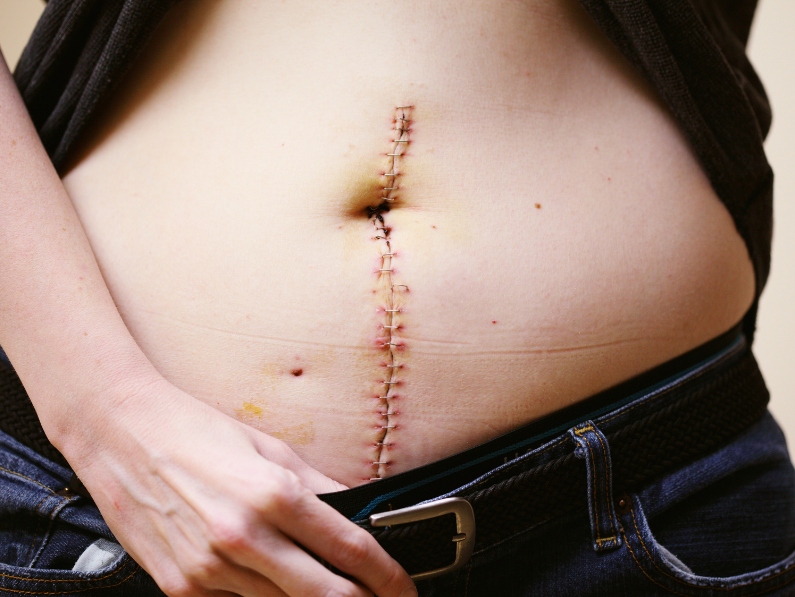Endo has contributed to various risks and complications to my health post-surgery. And it makes me feel like my battle with endometriosis will never be over. While I haven’t experienced the pain and severity of symptoms, I did pre-surgery. I now have conditions and increased health risks linked to endometriosis. Not to mention the increased likelihood that endometriosis can recur in the future. So, let’s talk about where I’m at two years post-surgery and how endo risks and complications play a significant role in my current health.
Page Contents
I’m Not Cured Just Symptom-Free
I don’t know who needs to hear this, but there’s no cure for endometriosis. You can have a successful excision surgery, a hysterectomy, or an oophorectomy and still not be cured. My case is no different. I still have endometriosis but don’t live with the severe pain and symptoms I used to. However, the likelihood that endometriosis will grow back is a harsh reality for me.
A study was conducted with 322 women that had successful excision surgeries. But unfortunately, what was found was that 234 of those women needed a second surgery. And, there were other cases in which a third surgery was necessary. On average, recurrence happened around 30 months for those with superficial peritoneal endometriosis and ovarian endometrioma subtypes. However, the average recurrence for deep infiltrating endometriosis was 36 months.
Furthermore, those with superficial peritoneal and ovarian endometrioma subtypes had a higher risk of endometriosis advancing to a higher subtype. For example, my subtype is ovarian endometrioma since there were endometriomas on both my left and right ovaries and endometriosis on my peritoneum. If it does recur, I’m at risk of having endometriosis progress to the deep infiltrating endometriosis subtype.
And while currently, I’m enjoying an improved quality of life, these risks are never far from my mind. Because being symptom-free doesn’t necessarily mean endometriosis-free. Endometriosis can grow without causing any visible symptoms, such as chronic pelvic pain and painful periods, which were two symptoms that were the worst for me. An additional issue is that there’s no way to test and monitor for endometriosis except for surgery. The only parameter to go off is pain level and visible symptoms such as endometriomas which can be seen via imaging tests such as an ultrasound.
Combining these factors makes managing expectations and life post-surgery a bit confusing. There’s no plan aside from birth control and hormonal treatments to prevent endometriosis. And I’m not a fan of hormonal interventions because they mask symptoms and disrupt hormonal balance even further. So, they’re not an option for me. I do practice lifestyle modifications with basic wellness principles like nutrition and exercise. But the big question becomes how you prevent a disease when you have no idea what causes it.
Ovary Removal Surgery Increased Endo Risks and Complications
In a prior post, I’ve discussed how losing my ovary created a hormonal imbalance and symptoms that led me to question if I was experiencing perimenopause. And, the truth is, most likely. Ovary removal surgery, referred to as an oophorectomy, creates hormonal complications that contribute to conditions such as Primary Ovarian Insufficiency (POI), Diminished Ovarian Reserve (DOR), and Perimenopause.
The ovaries fail to produce enough estrogen with POI, and ovulation occurs sporadically. However, with DOR, the ovary loses reproductive function, often caused by disease or damage to the ovary. And perimenopause is the transition to menopause and occurs in response to hormonal changes in the body.
These issues are typical for the type of surgery I had. Luckily there are ways to determine what’s happening via appropriate testing. For example, if I were seeking to become pregnant, I could test for DOR to decide whether I’m a viable candidate for fertility treatments. But since I’m no longer seeking to become pregnant, it’s not a worthwhile procedure to have. On the other hand, my symptoms’ likelihood of POI and perimenopause is high. While testing isn’t available for perimenopause, testing is available for POI under specific parameters I haven’t met yet. So, currently, it’s not an option.
However, this past summer, I tested my hormones and found a decline in estrogen, indicating that some of the symptoms I’m noticing are linked to perimenopause. I’ve since made the appropriate lifestyle changes to address my symptoms. And, I’m experimenting with supplements to combat irregular cycles and bleeding. But unfortunately, the jury’s still out on whether they’re effective or not.
High Blood Pressure and Cholesterol
Getting diagnosed with high blood pressure was a shock for me. I pride myself on leading an active lifestyle and following a well-balanced diet. So, hearing that I would need to take medication to control my blood pressure was difficult to comprehend.
And while a variety of nuances contributed to my high blood pressure, one element plays a crucial factor in the outcome. It’s the fact that I had my left ovary removed, and this has impacted my hormone balance and caused a slight decrease in estrogen production.
If you didn’t know, estrogen plays a vital role in the health of our blood vessels. Hence why your risk for heart disease increases as you begin perimenopause and menopause. Thus, making lifestyle modifications can aid in preventing this complication.
Furthermore, heart disease is linked to inflammation, and endometriosis is an inflammatory condition hence why heart disease risk increases.
A study was conducted over a 20-year period in which 116,000 female nurses between the ages of 25-42 were observed. Of the participants, 5% were diagnosed with endometriosis, and the rest weren’t. The results revealed that the endometriosis patients were at an increased risk of heart disease. In addition, 62% of endo patients had an elevated risk of heart attack, chest pain, or heart procedures for blocked arteries.
And the risk increased for those 40 years of age and younger. Additionally, those who had undergone uterus or ovary removal had an even greater risk of heart complications than those who had their uterus and ovaries.
Endometriosis Is A WHOLE-BODY Disease
Endometriosis impacts the entire body hence why discussing risks and complications is essential. While surgery and treatment ease pain and symptoms, there are tradeoffs. All endo patients face the uncertain reality of recurrence. Even with a successful excision surgery, there’s still a chance that endometriosis can grow back and could advance. In addition, your risk of conditions like primary ovarian insufficiency diminished ovarian reserve, and perimenopause increases with ovarian surgery.
Additionally, heart disease risk is increased with hysterectomy or ovary removal. High blood pressure and cholesterol are widely associated with declining estrogen levels. Furthermore, the inflammatory nature of endometriosis contributes to both high blood pressure and cholesterol.
These are a few of the risks and complications associated with endometriosis. I can share various other ways endometriosis has impacted my health. But the most important thing I hope you learn is the complexity of endometriosis. Reproductive health isn’t the only area it wreaks havoc on. There’s so much more to this disease than can be explained or understood.
References & Related Articles
NIH Endometriosis linked to increased risk for heart disease
Journal of Clinical Medicine February 9, 2020 (2) 496 published online February 11,2020 Recurrence Patterns after Surgery in Patients with Different Endometriosis Subtypes: A Long-Term Hospital Based Cohort Study
American Heart Association Journal May 30,2017 Association Between Endometriosis and Hypercholesterolemia or Hypertension










